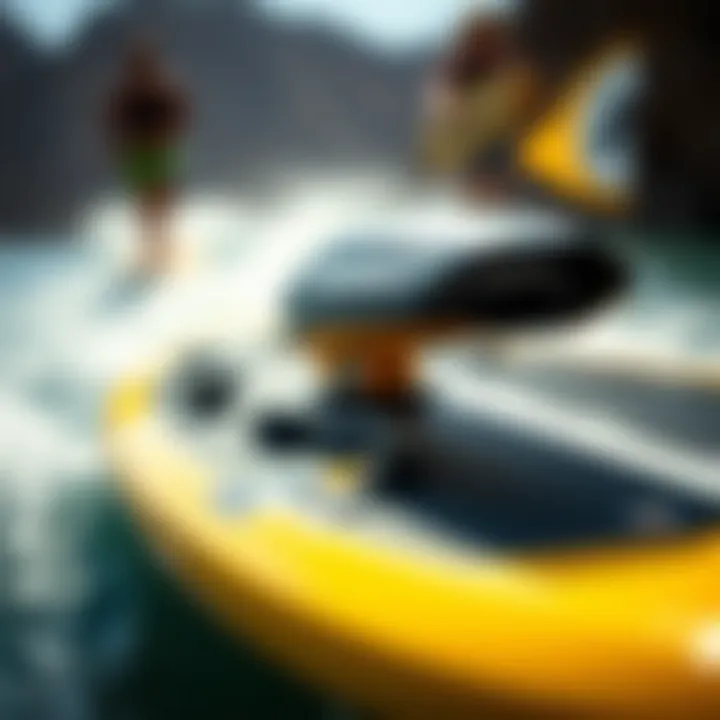Exploring the World of Motorized Surfboards


Intro
Motorized surfboards, once merely a vision of what water sports could embrace, have transformed into a captivating reality. With their roots tracing back to the mid-20th century, these boards have evolved significantly, carving out a niche in the broader watersports industry. The advent of technology blended with a love for the ocean has led us to what we witness today— a seamless fusion of surfing and motor power.
This exploration aims to uncover the depth of motorized surfboards, touching on design intricacies, historical developments, and the technological innovations that have pushed the boundaries of aquatic adventure. As we reflect on various types of surfboards prevalent today, safety considerations and environmental factors cannot be overlooked. There is much more beneath the surface, and unraveling these layers will not only enrich enthusiasts' understanding but also sharpen the awareness of curious bystanders.
So, let’s paddle out into these uncharted waters.
Prologue to Motorized Surfboards
Motorized surfboards are revolutionizing the watersports arena, offering a unique blend of traditional surfing thrills and advanced technology. As water sports enthusiasts increasingly seek innovative experiences, these boards make it possible to catch waves with the added power of an onboard motor. This section introduces motorized surfboards, illuminating their significance within the broader context of aquatic recreation today.
Definition and Basic Overview
Motorized surfboards, often referred to as e-surfboards or jet surfboards, are equipped with integrated electric motors or gas engines, allowing riders to speed across water without depending solely on ocean waves. The mechanics behind these boards enable a smoother ride, regardless of wave conditions. Riders can enjoy the thrill of surfing at any flat-water stretch—think lakes, rivers—without waiting for perfect waves. Unlike traditional surfing, where the ocean dictates the fun, motorized surfboards give users increased freedom and flexibility.
The boards typically come with rechargeable lithium-ion batteries, promising efficient, quiet performance. New technology keeps evolving, and the range of features may include wireless hand controls and varied speed settings to cater to the experience level of the rider. For instance, a beginner can start slow and increase speed as confidence grows. These boards can be quite the game-changer for those wanting to experience the rush of surfing in locations where waves might be less than ideal.
Historical Context
Motorized surfboards are a relatively new entrant in the long history of surfing. Traditional surfing can be traced back to ancient Polynesia, where waves dictated the fun of riding. The modern motorized surfboard began taking shape in the late 20th century as technology advanced and the desire for versatility grew among water sports lovers.
The early pioneers experimented with incorporating motors into surfboards, resulting in varying designs and performances. As interest burgeoned, manufacturers began refining designs, focusing on enhancing user experience and functionality. The shift from gasoline engines to electric motors also marked a significant turning point, as electric surfboards emerged with improved performance and cleaner energy.
By the 21st century, motorized surfboards transitioned from niche gadgets for the wealthy to more accessible options for general enthusiasts. Today, the increasing popularity of these innovations can be seen at various water sport events and in communities, enhancing the appeal of surfing to newer generations. With the wave of innovative designs, it’s clear that motorized surfboards are not just a passing fad; they're shaping the future of the sport.
"The future of surfing isn't just about riding waves; it's about exploring new dimensions of the water experience."
In summary, motorized surfboards have come a long way, with a clear definition rooted in innovation and an intriguing historical background. These developments have set the stage for an exciting exploration of technology, safety, and environmental impacts in the following sections.
The Technology Behind Motorized Surfboards
The world of motorized surfboards is not just about riding waves with an engine underfoot; it’s a marriage of advanced engineering and enjoyement on the water. Understanding the technology behind these surfboards is essential, as it unpacks the reasons for their growing popularity. Various components work in harmony to create a thrilling experience on the sea, pushing the boundaries of traditional surfing while catering to a new age of enthusiasts.
Components of Motorized Surfboards
Motor Types
When diving into motor types used in these surfboards, electric motors and gasoline-powered engines are the primary players. Each has its own charm: electric motors are lightweight and provide consistent thrust, making them a reliable choice for those looking to glide smoothly across the water. They tend to have a “quiet” reputation, being less intrusive to the serene marine environment. Conversely, gasoline engines often promise more power and a longer run time, attracting thrill-seekers eager for speed.
- Key Characteristic: Power output varies greatly between types, with electric motors generally offering 5-20 horsepower, while gas engines can reach upwards of 50 horsepower.
- Popular Choice: The electric option continues to gain momentum, especially among newcomers, due to its ease of use and minimal maintenance.
- Unique Feature: Electric motors provide quiet operation, so usage won’t scare fish or disrupt the peaceful atmosphere of a sunset ride. The downside? Limited range compared to gas motors makes long excursions tricky.
Batteries and Power Supply
The heart of an electric surfboard lies in its battery system. Advances in lithium-ion battery technology have propelled the performance of these boards to new heights. Riders can now enjoy greater range and faster charging times, improving the overall experience. As the saying goes, "The proof of the pudding is in the eating"—with motors running efficiently, it's the battery that keeps the party going.
- Key Characteristic: Modern batteries can last between 30 minutes to several hours, depending on how they're used.
- Beneficial Choice: Compact and powerful, lithium-ion batteries are a popular choice, allowing for lighter boards and extended ride times.
- Unique Feature: Some boards now come equipped with swappable batteries enabling users to change them out quickly during long sessions, although finding a charging station can be quite a task.
Materials Used
The construction materials for motorized surfboards significantly impact their performance and durability. Many manufacturers use a blend of high-density foam and fiberglass to strike the perfect balance between weight and strength. Lightweight materials improve maneuverability, while sturdy designs ensure lasting usage against pesky waves.


- Key Characteristic: The blend of materials contributes to a board's agility without compromising on resilience.
- Beneficial Choice: Carbon fiber has become increasingly popular for its strength-to-weight ratio and added longevity, though it can come with a heftier price tag.
- Unique Feature: Boards crafted from eco-friendly materials are beginning to appear, appealing to the environmentally conscious rider. However, the price point can deter some potential buyers.
Propulsion Mechanisms
Understanding propulsion mechanisms is vital for any aspiring rider. Each system is designed with a specific performance goal in mind, leading to varied riding experiences.
Jet Drives
Jet drives are becoming a popular choice for motorized surfboards because they offer a unique style of propulsion that is both effective and efficient. This system works by taking water in, pushing it through a nozzle at speed, providing immediate thrust.
- Key Characteristic: Jet drives create less turbulence behind the board, allowing for smoother handling on choppy waters.
- Popular Choice: They are prized for their ability to navigate shallow waters without damaging the marine ecosystem, making them a responsible option for adventurous riders.
- Unique Feature: They often come with built-in safety features that keep limbs from getting caught in moving parts, however, they can be more complex to maintain.
Propeller Subsystems
On the flip side, propeller subsystems use traditional propulsion techniques that have become mainstream in various watercraft. These systems initiate movement by spinning blades that push water behind, moving the board forward.
- Key Characteristic: Generally known for simplicity in design, propellers can offer high speeds.
- Beneficial Choice: For riders seeking velocity over leisurely scoots, propeller systems provide ample thrust.
- Unique Feature: While propellers can achieve impressive speeds, they also come with the downside of potential safety hazards and more maintenance due to moving parts.
In Summary: As technology continues to advance, various factors—from motor types to materials—allow riders to select boards that best suit their needs and preferences. From conservation considerations to performance, each choice is crucial in the ever-evolving landscape of motorized surfboards.
Varieties of Motorized Surfboards
The selection of motorized surfboards available today presents a thrilling array of choices for both enthusiasts and newcomers to the sport. This section dives into the different types of boards out there, emphasizing their unique characteristics and addressing important considerations when choosing between them. Having a solid understanding of the various varieties is essential for making informed decisions, which not only enhance the enjoyment of the sport but also contribute to a safer and more sustainable surfing experience.
Different Types Available
Electric Surfboards
Electric surfboards have gained quite a reputation in the realm of water sports. Unlike their gas counterparts, these boards run on battery power, which is a significant selling point for many users looking for a more environmentally friendly option. The key characteristic of electric surfboards is their quiet operation. This not only allows for a more serene experience on the water but also minimizes disturbance to marine life and other water enthusiasts.
One unique feature that stands out in electric boards is the powerful electric motor, often delivering a top speed of around 25 to 30 mph. This ability to go fast while being quieter makes them a popular choice for individuals who want a smooth ride without the roar of an engine. However, it’s worth noting that the duration of usage can be limited by battery life, sometimes creating a dilemma for longer outings. Additionally, these boards generally require a higher initial investment compared to gas-powered ones.
Gas-Powered Boards
On the flip side, gas-powered boards maintain a strong following due to their formidable power and performance. These boards typically deliver unmatchable speed and can cover larger distances due to their external fuel source. The key characteristic of gas-powered boards lies in their reliability for extended use. Enthusiasts often gravitate towards them for more rugged surfing adventures where electric boards might falter due to battery constraints.
A notable unique feature is the ability to refuel quickly, allowing for prolonged sessions on the water without the need for extensive breaks. Yet, one can’t ignore the downsides: gas boards tend to be heavier and noisier. Furthermore, they emit harmful exhaust fumes, leading to environmental concerns. Balancing these factors is crucial as one navigates through choices that align with their values and desired experiences.
Choosing the Right Board for Your Needs
Skill Level Considerations
When selecting a motorized surfboard, it is paramount to assess skill level. There’s a board for everyone, but not every board fits every rider. For novices, easier-to-handle electric surfboards are often advocated as they combine speed with a gentle learning curve, allowing more focus on enhancing skills rather than wrestling with technology.
Conversely, those with a bit of experience may find gas-powered models appealing for their rigorous demands. The thrill of controlling larger engines provides an exhilarating challenge that's hard to match. However, it also means one must have a solid grasp of basics to handle potential risks effectively. Ultimately, aligning skill level with board choice can enhance the riding experience significantly.
Budget and Pricing
Budget considerations loom large in the decision-making process when it comes to purchasing a motorized surfboard. Electric boards may often present a higher upfront cost due to their advanced technology and materials designed for durability. However, some might argue that the long-term savings on fuel and maintenance could outweigh initial expenses.
Gas-powered boards, while typically cheaper initially, come with ongoing fuel costs and maintenance considerations that could add up over time. This dichotomy of short-term versus long-term investment can weigh heavily on potential buyers. Understanding the total cost of ownership is crucial in helping one land on the perfect board while also staying within budget constraints. An open dialogue about one’s financial parameters can illuminate the best path forward.


"Choosing the right motorized surfboard isn’t just a purchase; it’s an investment in your water sports journey, paving the way for enjoyment, growth, and adventure."
Safety Considerations and Guidelines
When engaging in the thrilling pursuit of motorized surfing, safety is not simply a recommendation; it's a necessity. Understanding the right guidelines ensures that adventurers can enjoy their experience without unnecessary risks. These considerations revolve around wearing appropriate safety gear, knowing your environment, and conducting thorough equipment checks before heading out.
Essential Safety Gear
Life Jackets
A life jacket may well be the most critical piece of safety equipment for those attempting motorized surfboarding. It acts as a buoyancy aid; even if you fall off your board, it keeps you afloat, preventing any potential drowning incidents. Many life jackets designed for water sports are lightweight and streamline for minimum drag while you shred the waves. More commonly seen are the personal flotation devices (PFDs) that meet regulatory standards—these are pivotal in ensuring full compliance with local laws.
A major advantage here is their adaptability; many life jackets cater to various sizes and body types, thus ensuring comfort for all users. However, it's worth noting that life jackets vary, with some being bulkier than others. Yet, when seconds count, having that safety net is invaluable; a life jacket can even save your life in unpredictable situations.
Helmets
Helmets are another critical piece of equipment that shouldn't be overlooked. Motorized surfboards can reach impressive speeds, and a spill can occur faster than you'd think. Wearing a helmet helps protect your head during these moments of mishap, significantly reducing the risk of head injuries. A good helmet is made from materials that absorb impact while remaining lightweight and comfortable.
One attractive feature of modern helmets is the venting system that allows airflow, helping keep you cool under the sun. Although some might argue that helmets can be cumbersome, the safeguard they provide far outweighs the slight discomfort. Remember, it’s about making smart choices that allow you to focus on the waves and not worry about your safety.
Operating Safety Best Practices
Understanding Your Environment
The ocean or any body of water you venture onto has its characteristics—currents, waves, and underwater hazards all play a significant role in determining your safety. Gaining a robust understanding of the environment can greatly minimize risks. For instance, knowing about strong currents can help you avoid dangerous areas, ensuring that your surfing experience remains enjoyable.
Also, weather conditions can shift dramatically. Sudden storms can turn tranquil waters into a chaotic mess in a heartbeat. Therefore, being informed through local weather forecasts or surfing communities can save you from making a potentially dangerous mistake. Consider joining surfing forums or local clubs to tap into this wealth of information.
Pre-ride Checks
Conducting a thorough pre-ride check is not just a good practice; it's essential. Ensuring that the motor, battery, and all safety features are in optimal condition can make a world of difference. Imagine setting sail only to find out your board’s motor has issues halfway through your ride—frustrating, to say the least.
Key elements to examine include checking that the battery is charged, inspecting connections, and ensuring that all operational components respond correctly. Some surfers even carry a checklist to ensure nothing is overlooked. While this may seem tedious, it can prevent accidents and prolong the life of your board, making it a no-brainer for any responsible rider.
"Safety isn't about being a wimp; it’s about being smart. The ocean is exhilarating, but it’s also unpredictable. Gear up and stay savvy."
By integrating these safety considerations into your motorized surfing routine, you not only secure your own safety but also promote a culture of responsible recreation in the community.
Environmental Impact of Motorized Surfboards
When we look at the world of motorized surfboards, the environmental implications cannot be brushed aside. Much like any other water sport, these boards come with their own set of ecological footprints. It's vital to explore how these flashy toys affect our waters, both directly and indirectly. The discussion about environmental impact provides key insights that resonate with both enthusiasts and various stakeholders. It encourages responsibility among users while illuminating the potential hazards that may arise if we aren't vigilant.
Contribution to Water Pollution
Noise Pollution
Noise pollution is one area that often flies under the radar when discussing the effects of motorized surfboards. Unlike traditional surfing, which is a relatively serene activity, the roar of an engine can disrupt the tranquility of coastal waters. Think about it. When someone revs up their board, it doesn't just affect their own experience; it also competes with nature's chorus of waves and wildlife.
This loud mechanical sound can scare away marine life, pushing fish further from the shoreline and disturbing the natural balance. For communities reliant on fishing or eco-tourism, this is a major concern. The key characteristic of noise pollution here is its ability to pervade the surroundings, often going unnoticed until the damage is done.
It's crucial to highlight that while motorized surfboards cater to thrill-seekers, the disadvantage of increased noise can dampen the experience for others seeking peace in the water.


Chemical Concerns
Chemical concerns run deeper than just the eco-impact of noise. Motorized surfboards often use fuels or batteries that, when improperly maintained or disposed of, might leach harmful substances into waterways. This leads to contamination of aquatic ecosystems, affecting everything from fish to plant life.
The burning of fossil fuels, in particular, releases hydrocarbons and other pollutants that contribute not only to water but also air quality degradation. A standout point here is that while the initial thrill of these powered boards can be appealing, the long-term consequences are far less glamorous. As such, both users and manufacturers need to staying educated about chemical stewardship in this growing sector.
Sustainable Practices in the Industry
Fortunately, the market has begun leaning towards sustainable practices, aiming at mitigating the environmental footprint. Many companies are now focusing on creating electric surfboards, which reduce reliance on fossil fuels. Additionally, eco-friendly materials are gaining traction in board construction, further driving down negative impacts on nature.
Some manufacturers are deploying programs to encourage recycling of old boards and batteries to prevent harmful waste from polluting our waters. These strides not only ensure a cleaner playing field but also resonate with a modern audience that increasingly prioritizes green practices in all aspects of life.
The Future of Motorized Surfboards
Thinking about where motorized surfboards might head next isn’t just about shiny new toys. It’s about understanding how they can change the way we interact with water and the environment. As technology keeps pushing the boundaries, enthusiasts and future buyers alike will feel its impact. There’s no doubt that innovations will bring both benefits and newfound challenges—how they’re managed will shape the sport for many years to come.
Trends in Technology and Design
Advancements in Battery Technology
One major game changer in the surfboard industry is battery technology. Previously limited by short run times, newer batteries allow for longer rides without frequent interruptions. Lithium-ion batteries have become the gold standard due to their lightweight nature and high energy density. They serve as a reliable choice, enabling riders to explore more expansive waters without the nagging worry of running out of juice.
A unique characteristic of these new batteries is their capacity for rapid charging. While earlier models required hours to reach full power, advancements mean some can charge in under an hour. It's important, however, to mention that with the benefits come some downsides. Higher performance batteries can place a heavier financial burden on users, which might deter some newcomers to the sport.
Smart Features and Connectivity
Also noteworthy are the smart features appearing in motorized surfboards. The integration of GPS and connectivity options allows riders to track their speed, distance, and even environmental conditions. This not only enhances the overall experience but can also improve safety. Having data at your fingertips can help in making quick decisions out on the water.
However, incorporating these smart features can make the boards pricier. Not everyone might see the value in features like navigation systems when they are just starting. Yet, for seasoned riders looking to push their limits, these modern functions can represent a more engaging experience.
Market Growth and Opportunities
Emerging Markets
As motorized surfboards continue to gain traction, emerging markets present a promising avenue for growth. Regions like Southeast Asia, where beautiful coastlines meet increasing tourism, are seeing a rising interest in water sports. The accessibility of beaches and a warm climate make them ideal for setting up rental shops and riding schools.
In these emerging markets, the cost-effective options can lure in customers who are hesitant about committing to expensive gear. Nonetheless, while the opportunities are vast, it’s crucial to address the potential risks associated with environmental impacts and safety regulations—exceeding local guidelines can turn a profitable venture sour.
Consumer Preferences
Consumer preferences play a pivotal role in shaping the future of motorized surfboards. With sustainability on the minds of many, there's a distinct shift towards eco-friendly models. Consumers are more informed than ever about the environmental concerns posed by gas-powered boards. Sustainability is becoming a selling point; buyers often lean towards electric boards that promise a lower environmental footprint.
Yet, preferences can vary widely based on regions and demographics. Some might prioritize performance over sustainability, looking for speed and power, while others might seek the thrill combined with an eco-conscious approach. Balancing these preferences will be essential for brands aiming to thrive in this evolving market.
Ending
The exploration of motorized surfboards reveals a rapidly evolving segment of water sports that holds untold potential and challenges. This conclusion underscores several pivotal elements shaping the realm of motorized surfing.
First and foremost, it is essential to recognize how technology continues to push the boundaries in design and functionality. With advancements in battery life and propulsion systems, users can now glide over water seamlessly, enhancing both the experience and accessibility of surfing. The growth of this sport is partly fueled by innovations, making it captivating not only for seasoned surfers but also for novices eager to ride the waves.
Moreover, understanding the safety considerations involved is paramount. As thrilling as riding a motorized surfboard can be, prioritizing safety gear and best practices cannot be overstated. The experience can quickly turn sour if proper precautions are not observed, ranging from basic life jackets to environmental awareness during usage.
Finally, this article highlights the environmental implications surrounding motorized surfboards—both negative and positive. While concerns around noise pollution and potential chemical contaminants from batteries exist, the industry is beginning to embrace sustainable practices. This dual focus is crucial: ensuring the continued enjoyment of water sports while safeguarding aquatic ecosystems for future generations.
Summary of Key Insights
- Technological Advancements: Battery and propulsion technology has transformed the sport, making it more accessible.
- Safety Importance: Emphasis on the necessary safety gear and procedures can elevate user experience and minimize risks.
- Environmental Awareness: Acknowledging the ecological impact helps in fostering a sustainable approach to motorized surfing.
Closing Thoughts on the Sport
As we reflect on the journey of motorized surfboards, it becomes clear that they are not merely a trend but a significant evolution in water sports. The blend of thrills, innovation, and sheer enjoyment makes it an exciting time to be involved in the sport. However, it is imperative that enthusiasts remain conscious of safety and environmental stewardship. Moving forward, the collective efforts of users, manufacturers, and regulatory bodies can pave the way for a sustainable future in motorized surfing, ensuring that this exhilarating mode of recreation thrives for years to come.







